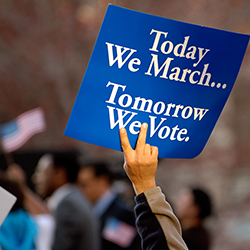Overcoming Challenges to Student Belonging at Majority-Minority Hispanic Serving Institution: A Competing Demands Framework
Christopher Donoghue (Montclair State University), Richard S. Reinschmidt (Montclair State University), Lauren Chow (Montclair State University), and Junius Gonzales (Montclair State University)
This presentation from researchers at Montclair University includes data and graphics to break down the makeup of students attending Montclair. The university has an average of 3,429 undergraduate students and used a stratified random class sample to gather data. About 38.9% of students responded to the survey, with 10% choosing to opt out of data linking.
One chart uses multiple graphs to analyze the students by race, gender, grade level, GPA, average age, recipients of Pell Grants, first-gen, and if they commute to campus. The second reports on students’ sense of peer support, faculty support, classroom comfort, and isolation. The final graphic is a multinomial analysis that takes the findings to determine which groups feel most comfortable and supported, and those who feel isolated and unsupported. Through this analysis, Montclair State University provides a framework for universities that will assist in awareness of which groups are struggling and the reasons contributing to that.
View the presentation material below:
Note from the authors
Sense of belonging is a fundamental human need that can raise the chances of self-actualization and academic success in college. Latine and other historically underrepresented student groups may experience greater challenges in this area than White students due to a greater propensity for feelings of belonging uncertainty, perceptions of inequality or experiences with microaggressions, or greater struggles with food and housing insecurities, even when they outnumber White students on campus. In this study, we utilized a person-centered approach to explore the heterogeneity in belonging in a large sample of undergraduate students (N=2,003) between the ages of 18 and 25 at a majority-minority Hispanic Serving Institution (HSI). We also used multinomial analysis to determine whether Latine and other non-White students, as well as those experiencing greater food and housing insecurities, were more likely to experience lower levels of belonging than their peers. The data pointed to three profiles of belonging, the lowest of which was characterized by low peer support and high isolation. Latine and Black students, and those experiencing more food and housing insecurities, were all more likely to identify with the Low Peer Support/High Isolation Profile.


